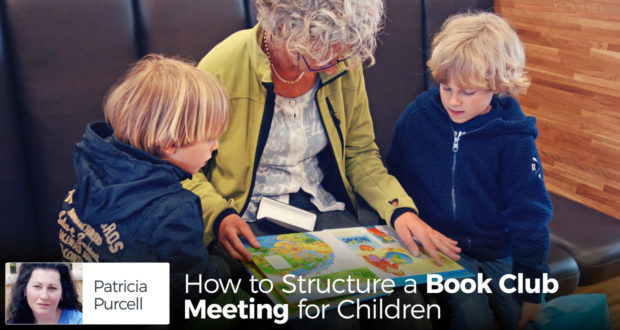Summary
Patricia Purcell shares her five steps to setting up a book club meeting, and how to inspire kids to join it and enjoy it too!Starting a book club for your child and their friends can lead to years of enjoyment for all involved.
It’s a great opportunity for kids to learn that exchanging ideas, and showing their knowledge, can be rewarding. Forming the club is just the beginning though.
Even with a group of well-behaved kids, carefully planning out the meetings ahead of time helps to ensure that everything flows smoothly at the meeting, rather than degenerating into chaos.
I have been running book clubs for my children for several years now, and my experiences with them have given me some insight on how to keep order, have fun, and provide an enriching activity for the kids involved. The planning gets easier with time, but here are a few helpful tips to get started.
1. Set Up a Reliable Communication System
It’s important to make it easy to contact the members of the group. Set up a group email, or a social media group that’s limited to the book club members (or their parents).
At least one month prior to the meeting, let the members know what book to read, the time and location of the meeting, who is scheduled to bring snacks, and any other pertinent information.
About one week before the meeting, send out a reminder notice. It may seem redundant, but we all know that busy parents sometimes are forgetful!
Having an easy means of communication comes in handy when there are last minute changes…trust me, there will be. My policy is to reschedule the meeting if one of my own children gets sick, if the weather is especially hazardous, or if more than half the group can’t make the meeting.
Thanks to our book club’s Yahoo group, sudden schedule changes are easy to handle (or at least as easy as it possibly can be to consider the availability of nine or ten different children).
2. Prepare the Discussion Questions Ahead of Time
Have you ever tried asking a group of children their opinion about something? That is, something other than favorite flavors of ice cream or TV shows?
Often, they will just stare back at you blankly, claiming amnesia, or at best, give a quick yes/no answer. Expecting the kids to manage a logical discussion about the assigned book without prompting would have equally disappointing results.
Come up with a list of questions ahead of time. There are many lists of discussion questions for various children’s favorites available online. It’s also easy to make your own. Make sure to have some more general questions, such as:
- Who was your favorite character? Why?
- What was your favorite scene? Why?
- Would you recommend this book? Why or why not?
Include some more targeted questions that cause the group to think, for example:
- What was the main character’s motivation for what he did?
- How did the setting affect the story?
- Could the story have ended differently? How?
When our book club was new, I would email the list of questions before the meeting so that the kids would have time to get ready for the discussion, and parents could help them if needed.
When kids are well prepared, they feel more comfortable expressing their opinions, especially when they know that they can back them up with examples from the book.
3. Have an Agenda for the Meeting
When the day of the meeting arrives, be ready. Have an agenda outlined and ready to follow. I have found that with children’s book clubs, it is best to start with the discussion. That way, the serious portion of the meeting is taken care of before attention spans start to wane, or rowdiness sets in. To help the discussion flow more smoothly:
Choose an object for the person speaking to hold, such as a decorated stick or small toy. It serves as a visual reminder that the rest of the group should be listening respectfully until it is their turn to speak.
Draw quiet kids out. Address questions directly to them, and prompt them to elaborate on their answers.
Limit chatterboxes. Some kids want to answer every question, which quickly becomes boring for the other members. Limit kids to answering only two or three questions until everyone has a chance to speak.
4. Add Some Extras
At the end of the discussion session, I invite kids to present facts that they’ve brought relating to anything about the books.
They can be about the author, time period, movie version, etc. For example, a book fact related to Little Women could be something about home-life during the American Civil War.
I find it gets the kids more involved in the book to do some research on their own. I bribe reward them with candy for doing this.
Our club also takes turns presenting book recommendations. It gives the kids a chance to practice public speaking, and persuade their friends to try a new book or author. We draw names out of a hat at each meeting to choose who gets to do it next.
5. The Fun Part
After the mental challenge of the discussion, it is time to lighten things up. Our group follows discussion with a snack. This is easy, as the moms all take turns providing snacks and drinks for the group.
Plan ahead for a book themed project or activity. Again, there are many wonderful ideas online. Some favorites of our group have been: sock animals, origami, Christmas ornaments, and dioramas. While the kids are eating, I show them the project that I have planned.
I make sure to have all of the supplies ready in advance, and a sample to display. If necessary, I demonstrate how to do the craft. Then, while the kids are crafting (and chatting), I get a chance to socialize with any parents that have returned.
When the craft is finished, the kids either have some free time to play, or do an activity related to the book. Our group has been introduced to some classic games this way, such as kick the can and marbles. The other parents and I have derived many a laugh from watching our modern, tech savvy kids chasing each other through the neighborhood just like children did in the past!
Putting time into planning each book club meeting is necessary in order to keep the kids focused, and ensure that they have plenty to keep them occupied. Taking care of details, such as questions and project components, ahead of time helps the day of the meeting to be stress free.
Over time, as everyone knows what to expect, running a meeting becomes ever easier.
When I see kids eagerly debating the points of a book, I feel that all of the work that I put into the club is worth it.

 Seton Magazine Catholic Homeschool Articles, Advice & Resources
Seton Magazine Catholic Homeschool Articles, Advice & Resources

